Improving Quality: Nurse Workload Analysis in Aged Residential Care
VerifiedAdded on 2023/06/11
|27
|4315
|227
Report
AI Summary
This report presents a quality improvement project focused on addressing the increased workload of nurses in an aged residential care facility. The project begins by acknowledging the challenges faced by healthcare organizations in meeting the needs of an aging population with complex medical conditions. It highlights a staff survey indicating that nurses feel valued but are concerned about increasing workloads, primarily due to legislative requirements and increased documentation. The project team used problem analysis tools like the 'five whys,' process mapping, check sheets, Pareto charts, and fishbone diagrams to identify the root causes, revealing that unplanned events such as falls and challenging behaviors significantly contribute to the increased workload. The report emphasizes the importance of preventative measures to reduce these incidents and recommends evidence-based practices to manage falls and challenging behavior, ultimately aiming to reduce nurse workload and improve patient outcomes. The recommendations provided in this quality report should be considered and implemented to ensure the delivery of safe, high-quality care to residents.
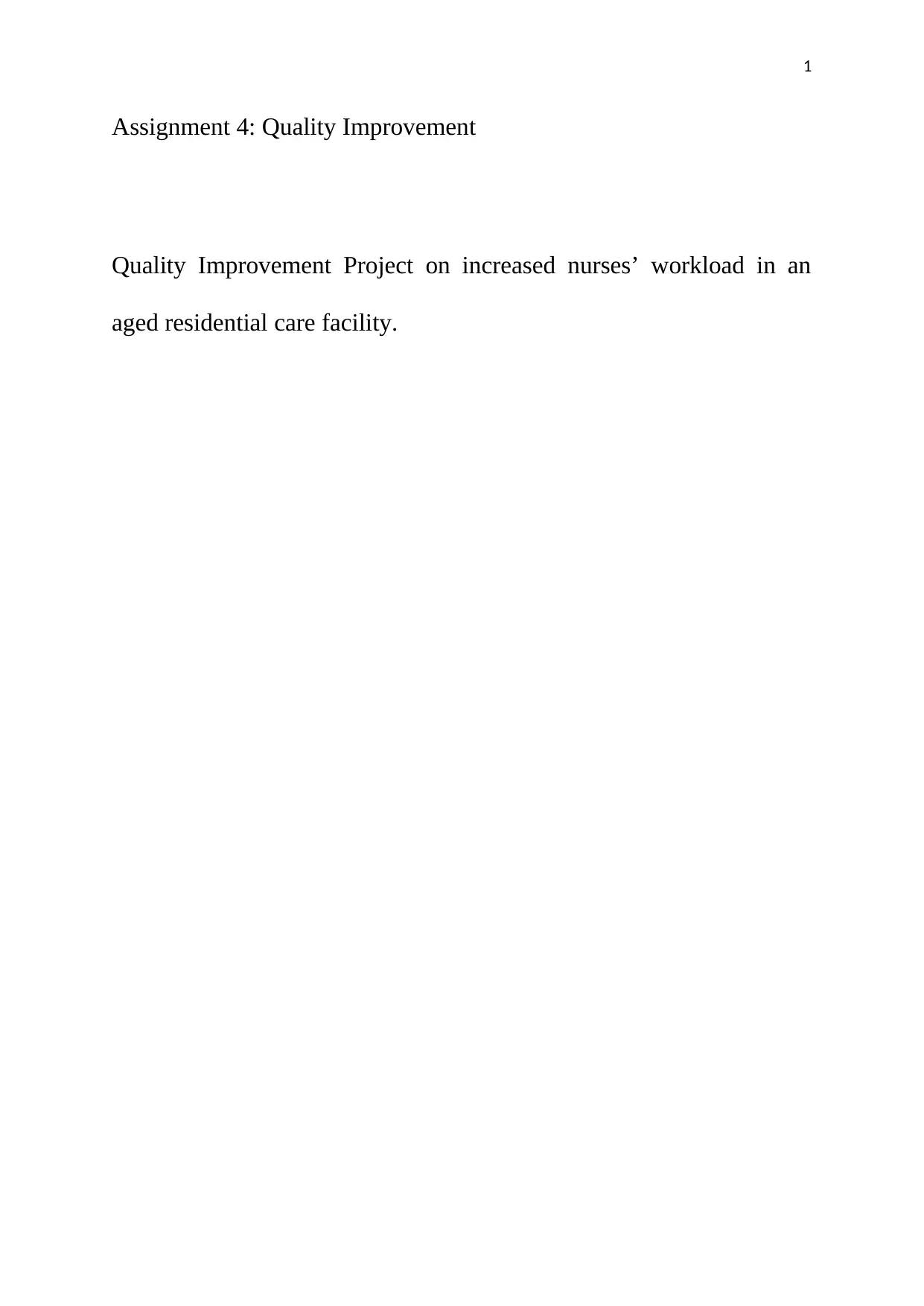
1
Assignment 4: Quality Improvement
Quality Improvement Project on increased nurses’ workload in an
aged residential care facility.
Assignment 4: Quality Improvement
Quality Improvement Project on increased nurses’ workload in an
aged residential care facility.
Paraphrase This Document
Need a fresh take? Get an instant paraphrase of this document with our AI Paraphraser
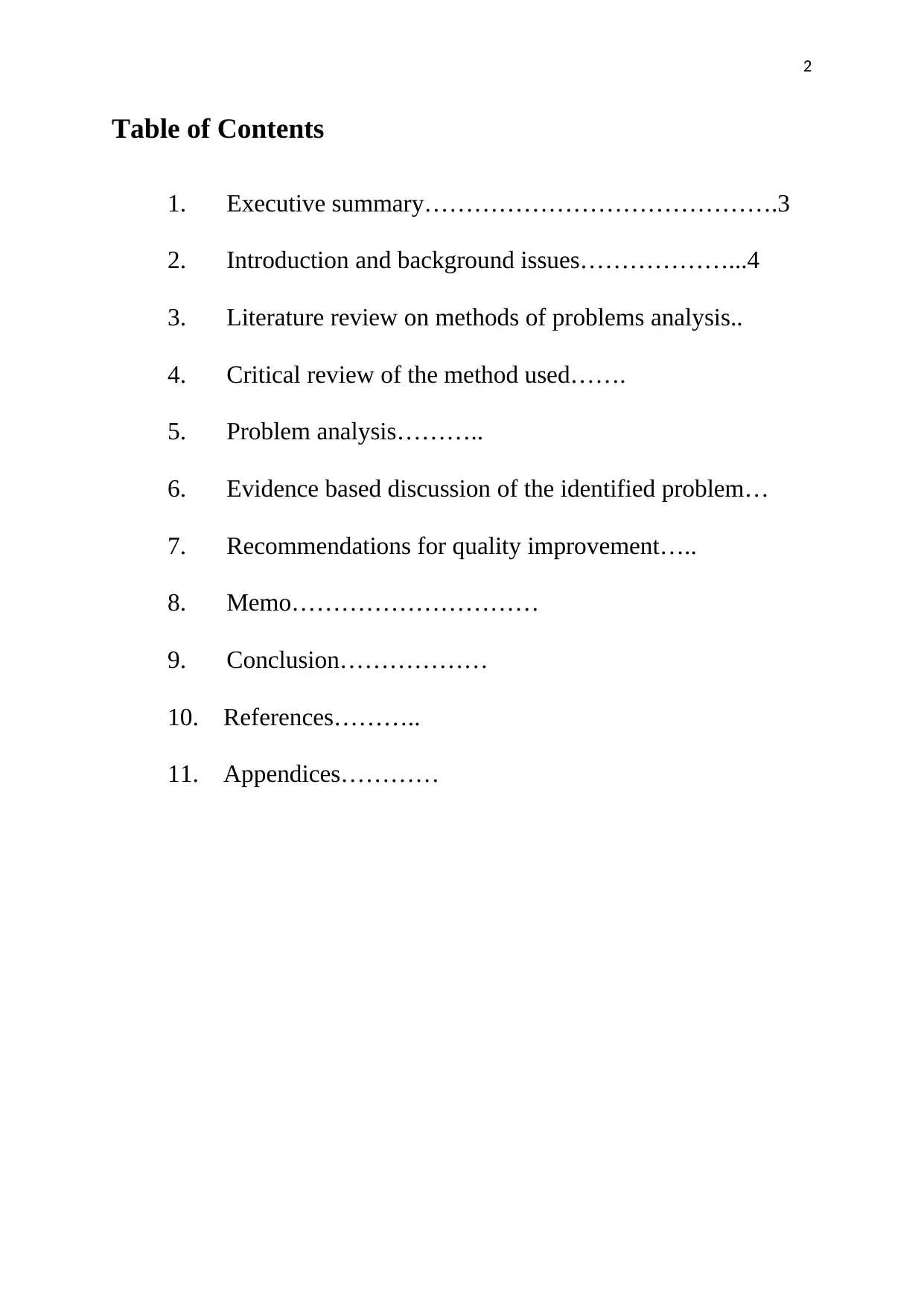
2
Table of Contents
1. Executive summary…………………………………….3
2. Introduction and background issues………………...4
3. Literature review on methods of problems analysis..
4. Critical review of the method used…….
5. Problem analysis………..
6. Evidence based discussion of the identified problem…
7. Recommendations for quality improvement…..
8. Memo…………………………
9. Conclusion………………
10. References………..
11. Appendices…………
Table of Contents
1. Executive summary…………………………………….3
2. Introduction and background issues………………...4
3. Literature review on methods of problems analysis..
4. Critical review of the method used…….
5. Problem analysis………..
6. Evidence based discussion of the identified problem…
7. Recommendations for quality improvement…..
8. Memo…………………………
9. Conclusion………………
10. References………..
11. Appendices…………
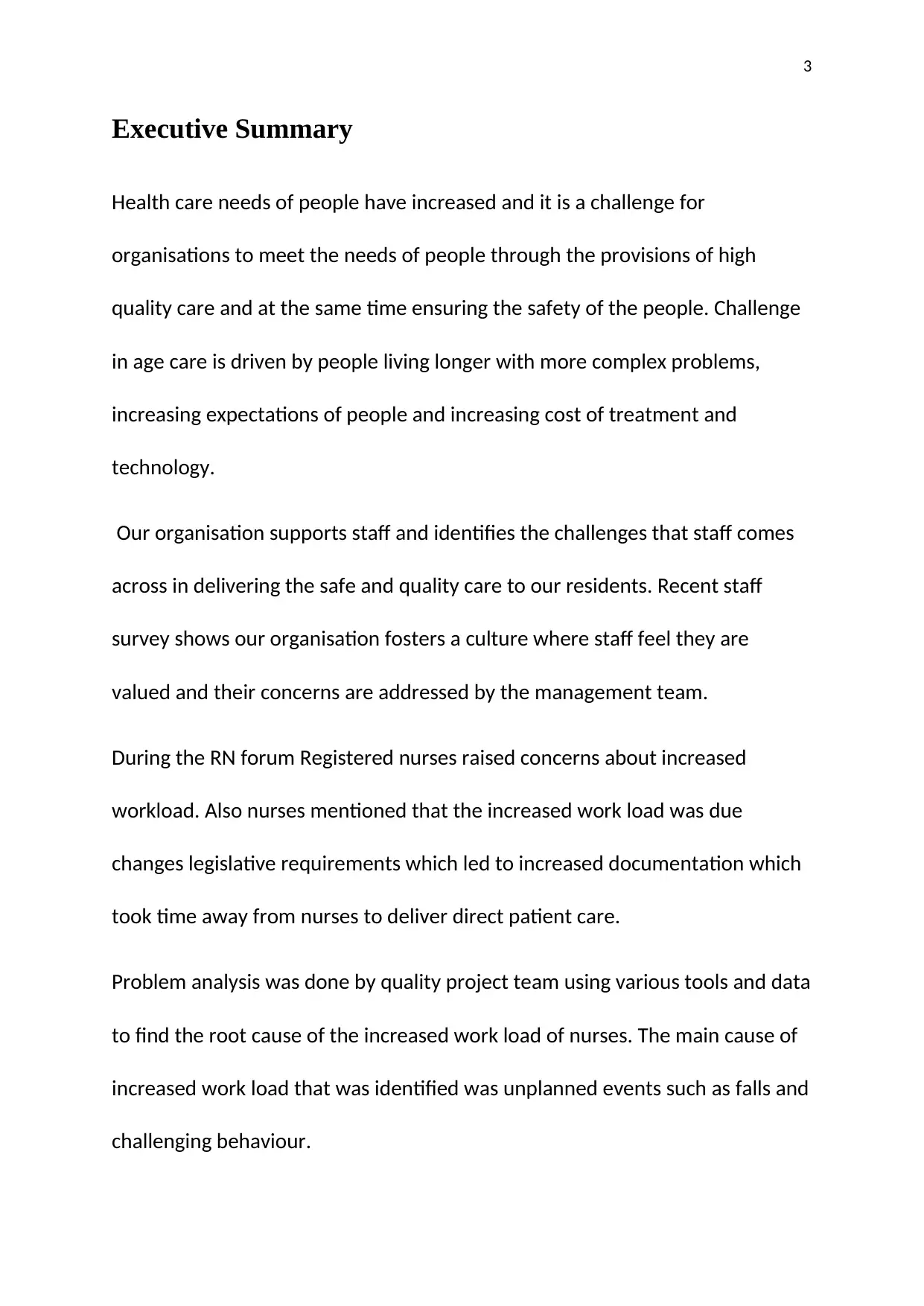
3
Executive Summary
Health care needs of people have increased and it is a challenge for
organisations to meet the needs of people through the provisions of high
quality care and at the same time ensuring the safety of the people. Challenge
in age care is driven by people living longer with more complex problems,
increasing expectations of people and increasing cost of treatment and
technology.
Our organisation supports staff and identifies the challenges that staff comes
across in delivering the safe and quality care to our residents. Recent staff
survey shows our organisation fosters a culture where staff feel they are
valued and their concerns are addressed by the management team.
During the RN forum Registered nurses raised concerns about increased
workload. Also nurses mentioned that the increased work load was due
changes legislative requirements which led to increased documentation which
took time away from nurses to deliver direct patient care.
Problem analysis was done by quality project team using various tools and data
to find the root cause of the increased work load of nurses. The main cause of
increased work load that was identified was unplanned events such as falls and
challenging behaviour.
Executive Summary
Health care needs of people have increased and it is a challenge for
organisations to meet the needs of people through the provisions of high
quality care and at the same time ensuring the safety of the people. Challenge
in age care is driven by people living longer with more complex problems,
increasing expectations of people and increasing cost of treatment and
technology.
Our organisation supports staff and identifies the challenges that staff comes
across in delivering the safe and quality care to our residents. Recent staff
survey shows our organisation fosters a culture where staff feel they are
valued and their concerns are addressed by the management team.
During the RN forum Registered nurses raised concerns about increased
workload. Also nurses mentioned that the increased work load was due
changes legislative requirements which led to increased documentation which
took time away from nurses to deliver direct patient care.
Problem analysis was done by quality project team using various tools and data
to find the root cause of the increased work load of nurses. The main cause of
increased work load that was identified was unplanned events such as falls and
challenging behaviour.
⊘ This is a preview!⊘
Do you want full access?
Subscribe today to unlock all pages.

Trusted by 1+ million students worldwide
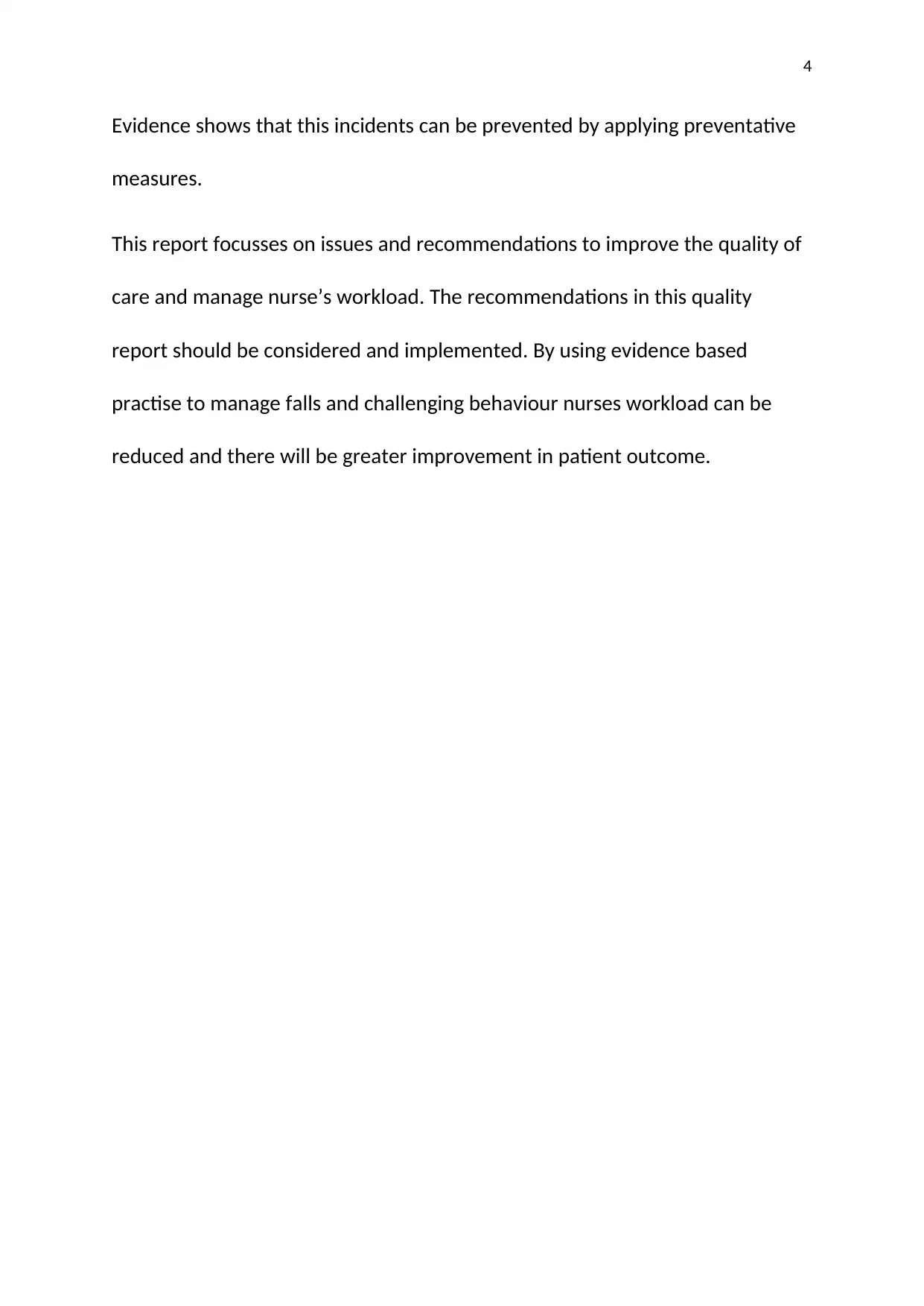
4
Evidence shows that this incidents can be prevented by applying preventative
measures.
This report focusses on issues and recommendations to improve the quality of
care and manage nurse’s workload. The recommendations in this quality
report should be considered and implemented. By using evidence based
practise to manage falls and challenging behaviour nurses workload can be
reduced and there will be greater improvement in patient outcome.
Evidence shows that this incidents can be prevented by applying preventative
measures.
This report focusses on issues and recommendations to improve the quality of
care and manage nurse’s workload. The recommendations in this quality
report should be considered and implemented. By using evidence based
practise to manage falls and challenging behaviour nurses workload can be
reduced and there will be greater improvement in patient outcome.
Paraphrase This Document
Need a fresh take? Get an instant paraphrase of this document with our AI Paraphraser
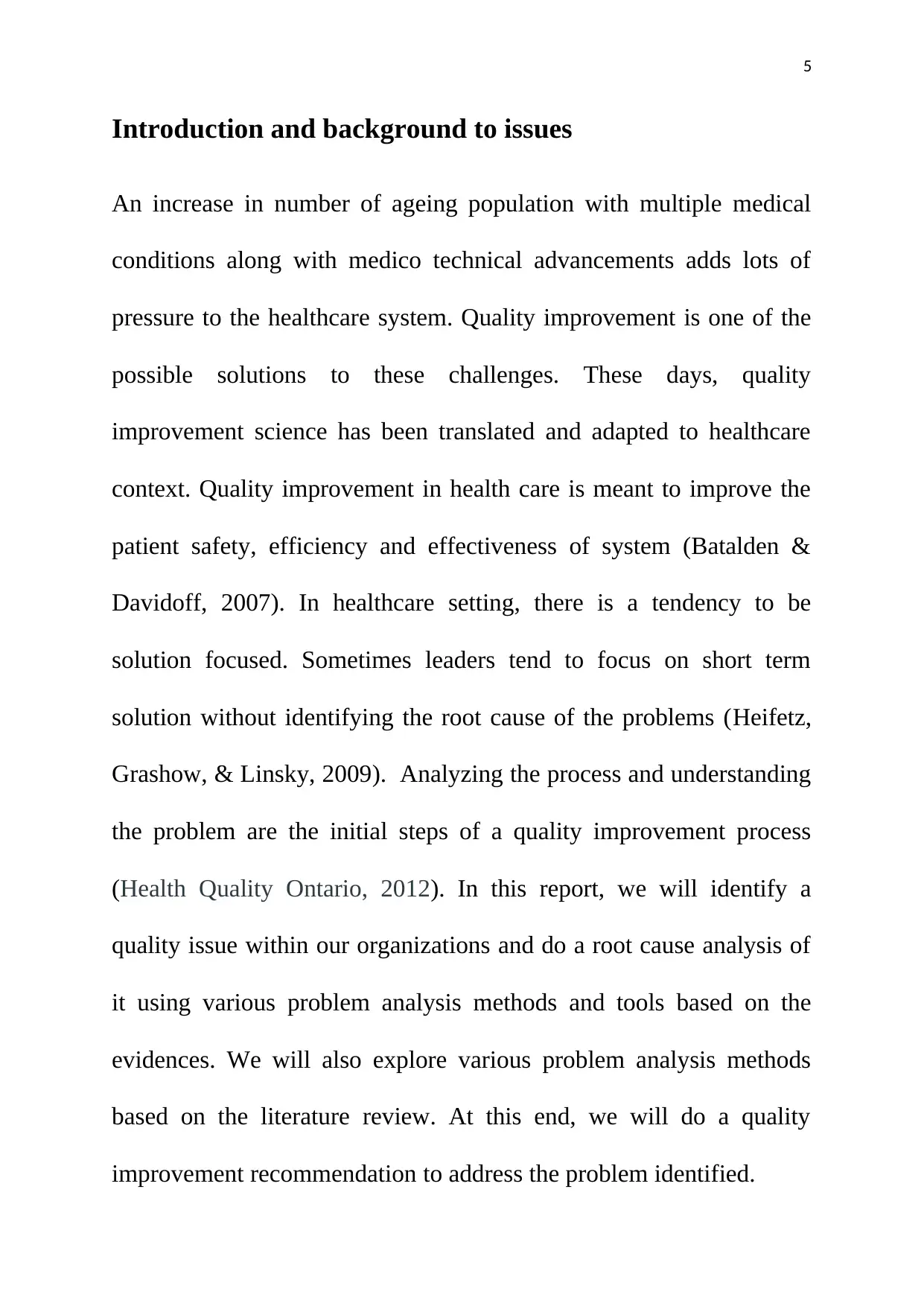
5
Introduction and background to issues
An increase in number of ageing population with multiple medical
conditions along with medico technical advancements adds lots of
pressure to the healthcare system. Quality improvement is one of the
possible solutions to these challenges. These days, quality
improvement science has been translated and adapted to healthcare
context. Quality improvement in health care is meant to improve the
patient safety, efficiency and effectiveness of system (Batalden &
Davidoff, 2007). In healthcare setting, there is a tendency to be
solution focused. Sometimes leaders tend to focus on short term
solution without identifying the root cause of the problems (Heifetz,
Grashow, & Linsky, 2009). Analyzing the process and understanding
the problem are the initial steps of a quality improvement process
(Health Quality Ontario, 2012). In this report, we will identify a
quality issue within our organizations and do a root cause analysis of
it using various problem analysis methods and tools based on the
evidences. We will also explore various problem analysis methods
based on the literature review. At this end, we will do a quality
improvement recommendation to address the problem identified.
Introduction and background to issues
An increase in number of ageing population with multiple medical
conditions along with medico technical advancements adds lots of
pressure to the healthcare system. Quality improvement is one of the
possible solutions to these challenges. These days, quality
improvement science has been translated and adapted to healthcare
context. Quality improvement in health care is meant to improve the
patient safety, efficiency and effectiveness of system (Batalden &
Davidoff, 2007). In healthcare setting, there is a tendency to be
solution focused. Sometimes leaders tend to focus on short term
solution without identifying the root cause of the problems (Heifetz,
Grashow, & Linsky, 2009). Analyzing the process and understanding
the problem are the initial steps of a quality improvement process
(Health Quality Ontario, 2012). In this report, we will identify a
quality issue within our organizations and do a root cause analysis of
it using various problem analysis methods and tools based on the
evidences. We will also explore various problem analysis methods
based on the literature review. At this end, we will do a quality
improvement recommendation to address the problem identified.
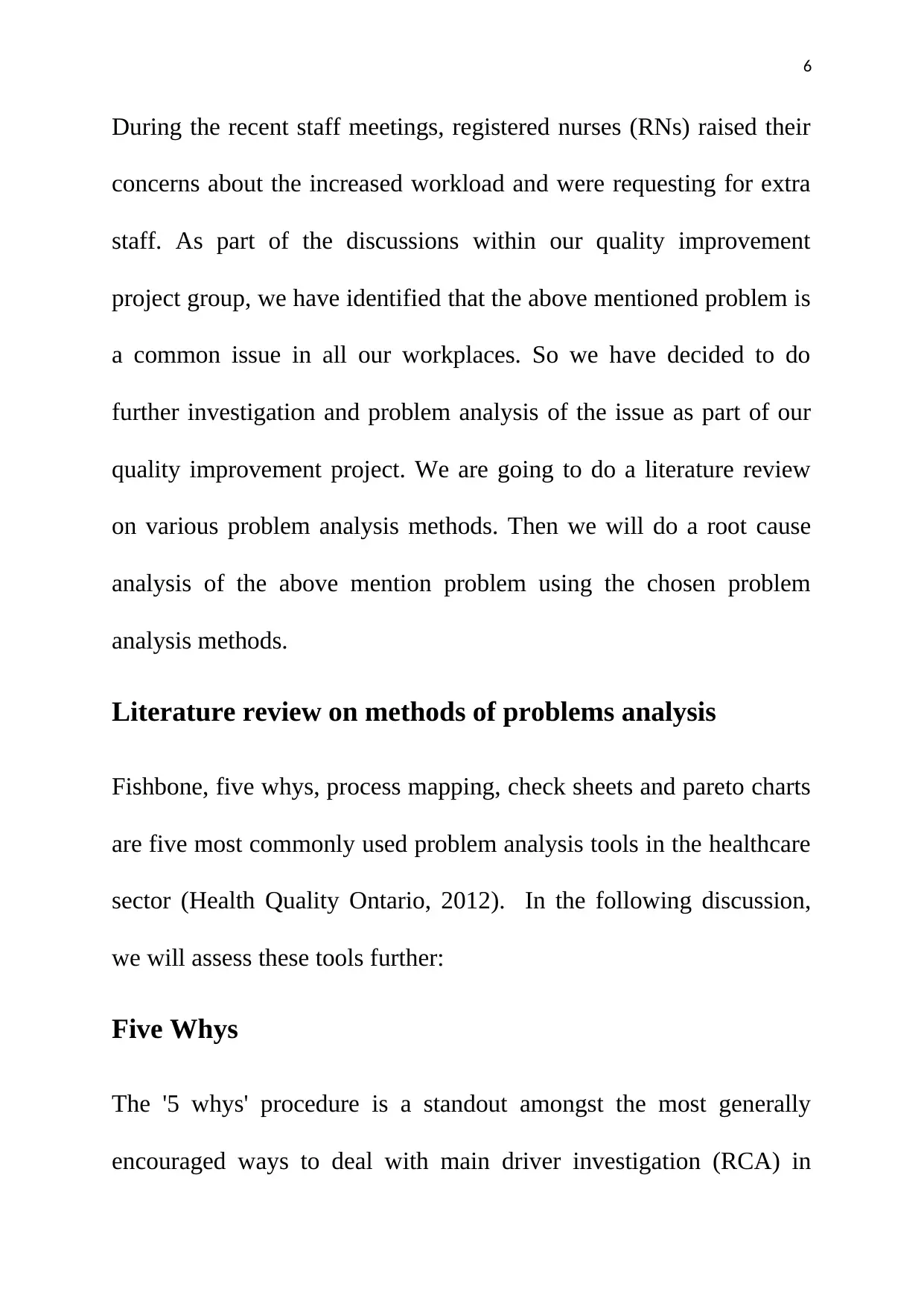
6
During the recent staff meetings, registered nurses (RNs) raised their
concerns about the increased workload and were requesting for extra
staff. As part of the discussions within our quality improvement
project group, we have identified that the above mentioned problem is
a common issue in all our workplaces. So we have decided to do
further investigation and problem analysis of the issue as part of our
quality improvement project. We are going to do a literature review
on various problem analysis methods. Then we will do a root cause
analysis of the above mention problem using the chosen problem
analysis methods.
Literature review on methods of problems analysis
Fishbone, five whys, process mapping, check sheets and pareto charts
are five most commonly used problem analysis tools in the healthcare
sector (Health Quality Ontario, 2012). In the following discussion,
we will assess these tools further:
Five Whys
The '5 whys' procedure is a standout amongst the most generally
encouraged ways to deal with main driver investigation (RCA) in
During the recent staff meetings, registered nurses (RNs) raised their
concerns about the increased workload and were requesting for extra
staff. As part of the discussions within our quality improvement
project group, we have identified that the above mentioned problem is
a common issue in all our workplaces. So we have decided to do
further investigation and problem analysis of the issue as part of our
quality improvement project. We are going to do a literature review
on various problem analysis methods. Then we will do a root cause
analysis of the above mention problem using the chosen problem
analysis methods.
Literature review on methods of problems analysis
Fishbone, five whys, process mapping, check sheets and pareto charts
are five most commonly used problem analysis tools in the healthcare
sector (Health Quality Ontario, 2012). In the following discussion,
we will assess these tools further:
Five Whys
The '5 whys' procedure is a standout amongst the most generally
encouraged ways to deal with main driver investigation (RCA) in
⊘ This is a preview!⊘
Do you want full access?
Subscribe today to unlock all pages.

Trusted by 1+ million students worldwide
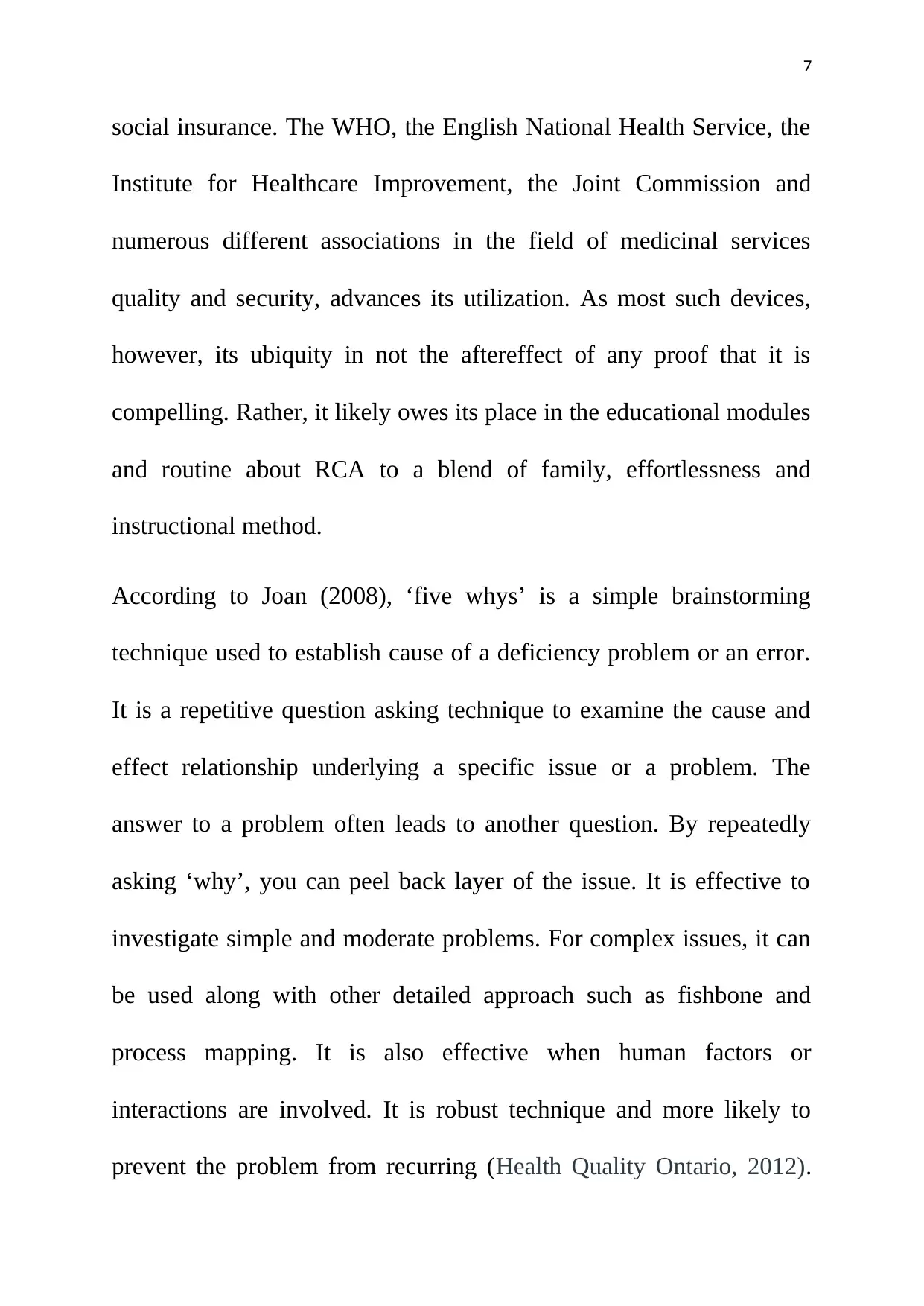
7
social insurance. The WHO, the English National Health Service, the
Institute for Healthcare Improvement, the Joint Commission and
numerous different associations in the field of medicinal services
quality and security, advances its utilization. As most such devices,
however, its ubiquity in not the aftereffect of any proof that it is
compelling. Rather, it likely owes its place in the educational modules
and routine about RCA to a blend of family, effortlessness and
instructional method.
According to Joan (2008), ‘five whys’ is a simple brainstorming
technique used to establish cause of a deficiency problem or an error.
It is a repetitive question asking technique to examine the cause and
effect relationship underlying a specific issue or a problem. The
answer to a problem often leads to another question. By repeatedly
asking ‘why’, you can peel back layer of the issue. It is effective to
investigate simple and moderate problems. For complex issues, it can
be used along with other detailed approach such as fishbone and
process mapping. It is also effective when human factors or
interactions are involved. It is robust technique and more likely to
prevent the problem from recurring (Health Quality Ontario, 2012).
social insurance. The WHO, the English National Health Service, the
Institute for Healthcare Improvement, the Joint Commission and
numerous different associations in the field of medicinal services
quality and security, advances its utilization. As most such devices,
however, its ubiquity in not the aftereffect of any proof that it is
compelling. Rather, it likely owes its place in the educational modules
and routine about RCA to a blend of family, effortlessness and
instructional method.
According to Joan (2008), ‘five whys’ is a simple brainstorming
technique used to establish cause of a deficiency problem or an error.
It is a repetitive question asking technique to examine the cause and
effect relationship underlying a specific issue or a problem. The
answer to a problem often leads to another question. By repeatedly
asking ‘why’, you can peel back layer of the issue. It is effective to
investigate simple and moderate problems. For complex issues, it can
be used along with other detailed approach such as fishbone and
process mapping. It is also effective when human factors or
interactions are involved. It is robust technique and more likely to
prevent the problem from recurring (Health Quality Ontario, 2012).
Paraphrase This Document
Need a fresh take? Get an instant paraphrase of this document with our AI Paraphraser
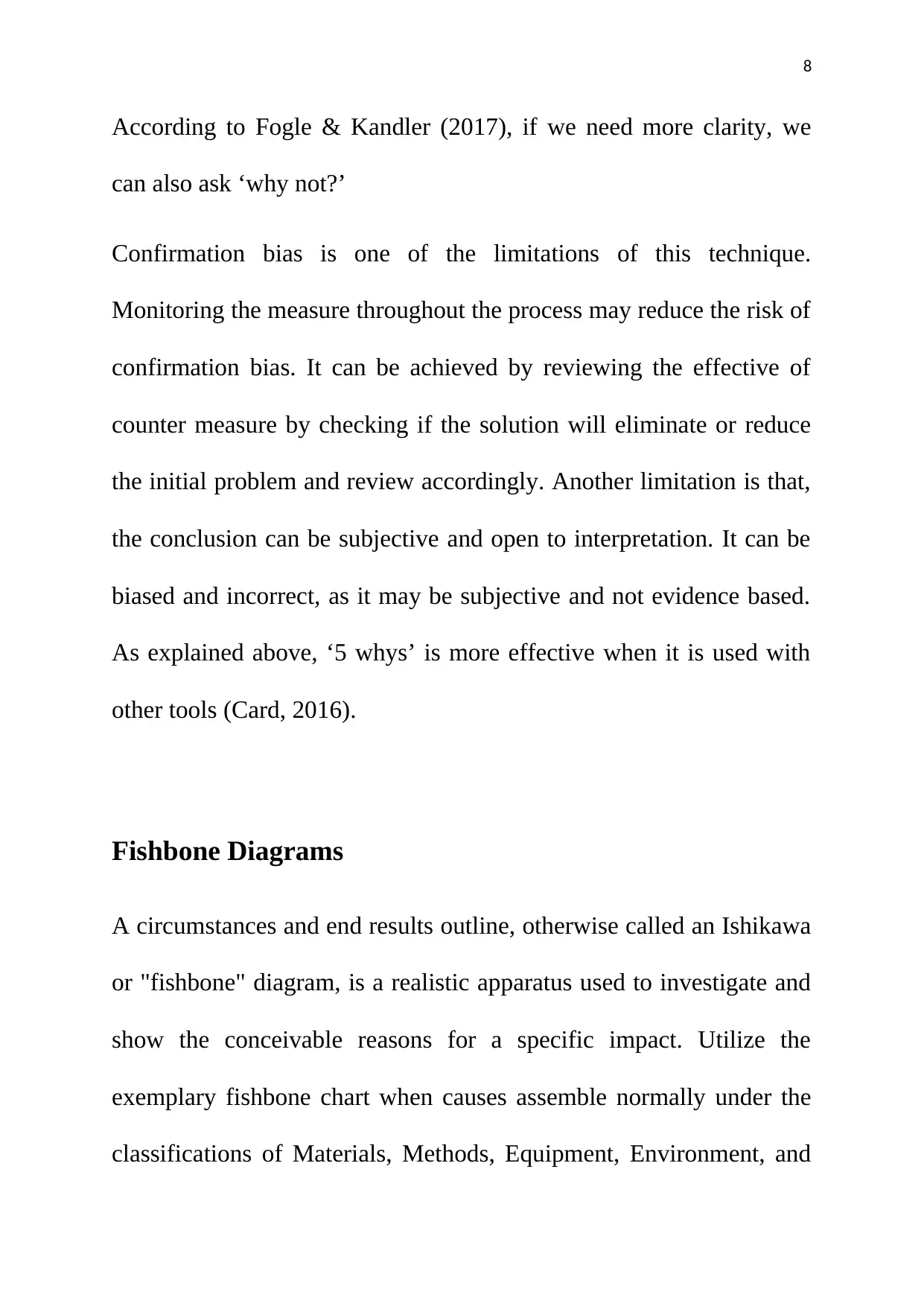
8
According to Fogle & Kandler (2017), if we need more clarity, we
can also ask ‘why not?’
Confirmation bias is one of the limitations of this technique.
Monitoring the measure throughout the process may reduce the risk of
confirmation bias. It can be achieved by reviewing the effective of
counter measure by checking if the solution will eliminate or reduce
the initial problem and review accordingly. Another limitation is that,
the conclusion can be subjective and open to interpretation. It can be
biased and incorrect, as it may be subjective and not evidence based.
As explained above, ‘5 whys’ is more effective when it is used with
other tools (Card, 2016).
Fishbone Diagrams
A circumstances and end results outline, otherwise called an Ishikawa
or "fishbone" diagram, is a realistic apparatus used to investigate and
show the conceivable reasons for a specific impact. Utilize the
exemplary fishbone chart when causes assemble normally under the
classifications of Materials, Methods, Equipment, Environment, and
According to Fogle & Kandler (2017), if we need more clarity, we
can also ask ‘why not?’
Confirmation bias is one of the limitations of this technique.
Monitoring the measure throughout the process may reduce the risk of
confirmation bias. It can be achieved by reviewing the effective of
counter measure by checking if the solution will eliminate or reduce
the initial problem and review accordingly. Another limitation is that,
the conclusion can be subjective and open to interpretation. It can be
biased and incorrect, as it may be subjective and not evidence based.
As explained above, ‘5 whys’ is more effective when it is used with
other tools (Card, 2016).
Fishbone Diagrams
A circumstances and end results outline, otherwise called an Ishikawa
or "fishbone" diagram, is a realistic apparatus used to investigate and
show the conceivable reasons for a specific impact. Utilize the
exemplary fishbone chart when causes assemble normally under the
classifications of Materials, Methods, Equipment, Environment, and
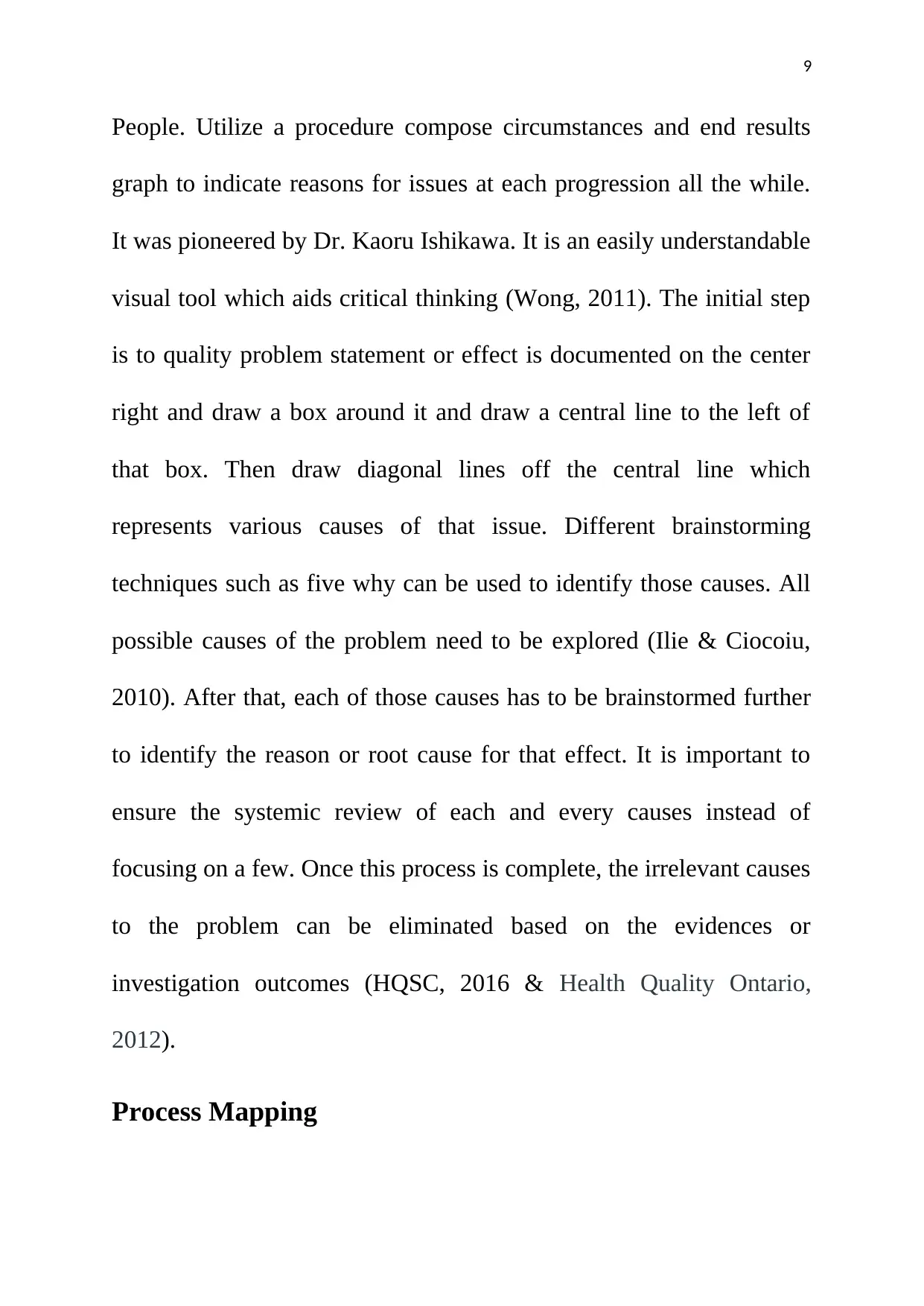
9
People. Utilize a procedure compose circumstances and end results
graph to indicate reasons for issues at each progression all the while.
It was pioneered by Dr. Kaoru Ishikawa. It is an easily understandable
visual tool which aids critical thinking (Wong, 2011). The initial step
is to quality problem statement or effect is documented on the center
right and draw a box around it and draw a central line to the left of
that box. Then draw diagonal lines off the central line which
represents various causes of that issue. Different brainstorming
techniques such as five why can be used to identify those causes. All
possible causes of the problem need to be explored (Ilie & Ciocoiu,
2010). After that, each of those causes has to be brainstormed further
to identify the reason or root cause for that effect. It is important to
ensure the systemic review of each and every causes instead of
focusing on a few. Once this process is complete, the irrelevant causes
to the problem can be eliminated based on the evidences or
investigation outcomes (HQSC, 2016 & Health Quality Ontario,
2012).
Process Mapping
People. Utilize a procedure compose circumstances and end results
graph to indicate reasons for issues at each progression all the while.
It was pioneered by Dr. Kaoru Ishikawa. It is an easily understandable
visual tool which aids critical thinking (Wong, 2011). The initial step
is to quality problem statement or effect is documented on the center
right and draw a box around it and draw a central line to the left of
that box. Then draw diagonal lines off the central line which
represents various causes of that issue. Different brainstorming
techniques such as five why can be used to identify those causes. All
possible causes of the problem need to be explored (Ilie & Ciocoiu,
2010). After that, each of those causes has to be brainstormed further
to identify the reason or root cause for that effect. It is important to
ensure the systemic review of each and every causes instead of
focusing on a few. Once this process is complete, the irrelevant causes
to the problem can be eliminated based on the evidences or
investigation outcomes (HQSC, 2016 & Health Quality Ontario,
2012).
Process Mapping
⊘ This is a preview!⊘
Do you want full access?
Subscribe today to unlock all pages.

Trusted by 1+ million students worldwide
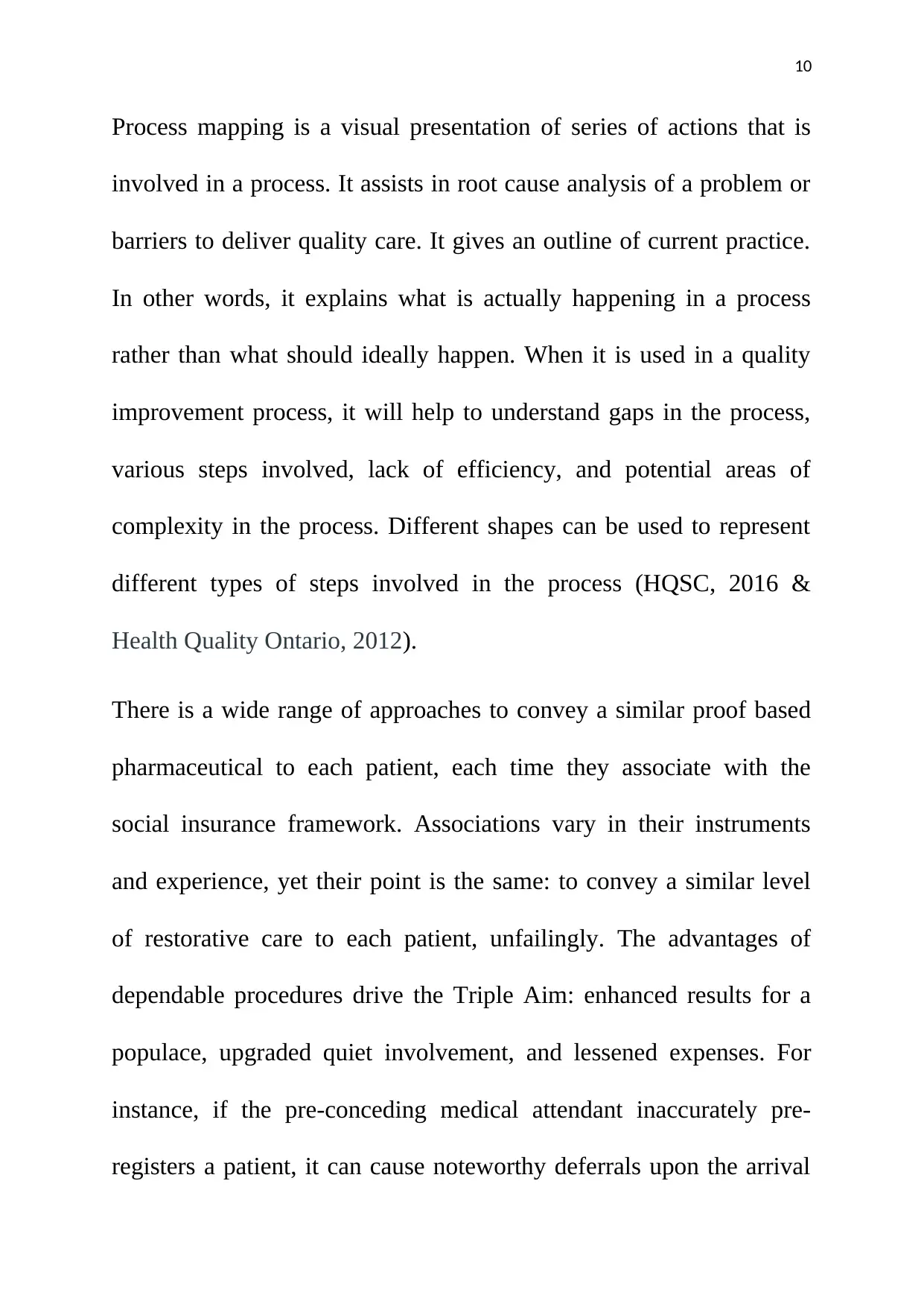
10
Process mapping is a visual presentation of series of actions that is
involved in a process. It assists in root cause analysis of a problem or
barriers to deliver quality care. It gives an outline of current practice.
In other words, it explains what is actually happening in a process
rather than what should ideally happen. When it is used in a quality
improvement process, it will help to understand gaps in the process,
various steps involved, lack of efficiency, and potential areas of
complexity in the process. Different shapes can be used to represent
different types of steps involved in the process (HQSC, 2016 &
Health Quality Ontario, 2012).
There is a wide range of approaches to convey a similar proof based
pharmaceutical to each patient, each time they associate with the
social insurance framework. Associations vary in their instruments
and experience, yet their point is the same: to convey a similar level
of restorative care to each patient, unfailingly. The advantages of
dependable procedures drive the Triple Aim: enhanced results for a
populace, upgraded quiet involvement, and lessened expenses. For
instance, if the pre-conceding medical attendant inaccurately pre-
registers a patient, it can cause noteworthy deferrals upon the arrival
Process mapping is a visual presentation of series of actions that is
involved in a process. It assists in root cause analysis of a problem or
barriers to deliver quality care. It gives an outline of current practice.
In other words, it explains what is actually happening in a process
rather than what should ideally happen. When it is used in a quality
improvement process, it will help to understand gaps in the process,
various steps involved, lack of efficiency, and potential areas of
complexity in the process. Different shapes can be used to represent
different types of steps involved in the process (HQSC, 2016 &
Health Quality Ontario, 2012).
There is a wide range of approaches to convey a similar proof based
pharmaceutical to each patient, each time they associate with the
social insurance framework. Associations vary in their instruments
and experience, yet their point is the same: to convey a similar level
of restorative care to each patient, unfailingly. The advantages of
dependable procedures drive the Triple Aim: enhanced results for a
populace, upgraded quiet involvement, and lessened expenses. For
instance, if the pre-conceding medical attendant inaccurately pre-
registers a patient, it can cause noteworthy deferrals upon the arrival
Paraphrase This Document
Need a fresh take? Get an instant paraphrase of this document with our AI Paraphraser
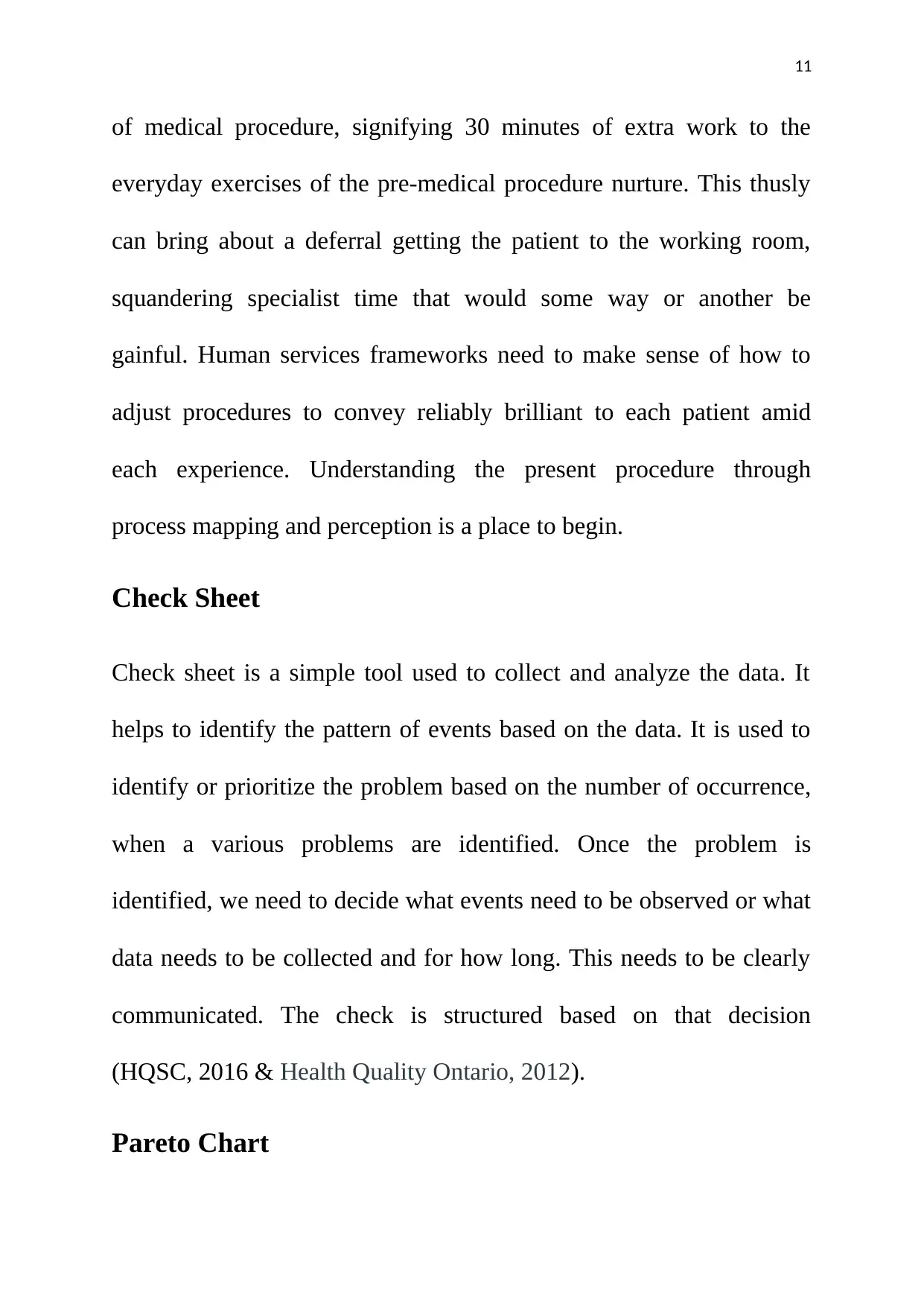
11
of medical procedure, signifying 30 minutes of extra work to the
everyday exercises of the pre-medical procedure nurture. This thusly
can bring about a deferral getting the patient to the working room,
squandering specialist time that would some way or another be
gainful. Human services frameworks need to make sense of how to
adjust procedures to convey reliably brilliant to each patient amid
each experience. Understanding the present procedure through
process mapping and perception is a place to begin.
Check Sheet
Check sheet is a simple tool used to collect and analyze the data. It
helps to identify the pattern of events based on the data. It is used to
identify or prioritize the problem based on the number of occurrence,
when a various problems are identified. Once the problem is
identified, we need to decide what events need to be observed or what
data needs to be collected and for how long. This needs to be clearly
communicated. The check is structured based on that decision
(HQSC, 2016 & Health Quality Ontario, 2012).
Pareto Chart
of medical procedure, signifying 30 minutes of extra work to the
everyday exercises of the pre-medical procedure nurture. This thusly
can bring about a deferral getting the patient to the working room,
squandering specialist time that would some way or another be
gainful. Human services frameworks need to make sense of how to
adjust procedures to convey reliably brilliant to each patient amid
each experience. Understanding the present procedure through
process mapping and perception is a place to begin.
Check Sheet
Check sheet is a simple tool used to collect and analyze the data. It
helps to identify the pattern of events based on the data. It is used to
identify or prioritize the problem based on the number of occurrence,
when a various problems are identified. Once the problem is
identified, we need to decide what events need to be observed or what
data needs to be collected and for how long. This needs to be clearly
communicated. The check is structured based on that decision
(HQSC, 2016 & Health Quality Ontario, 2012).
Pareto Chart
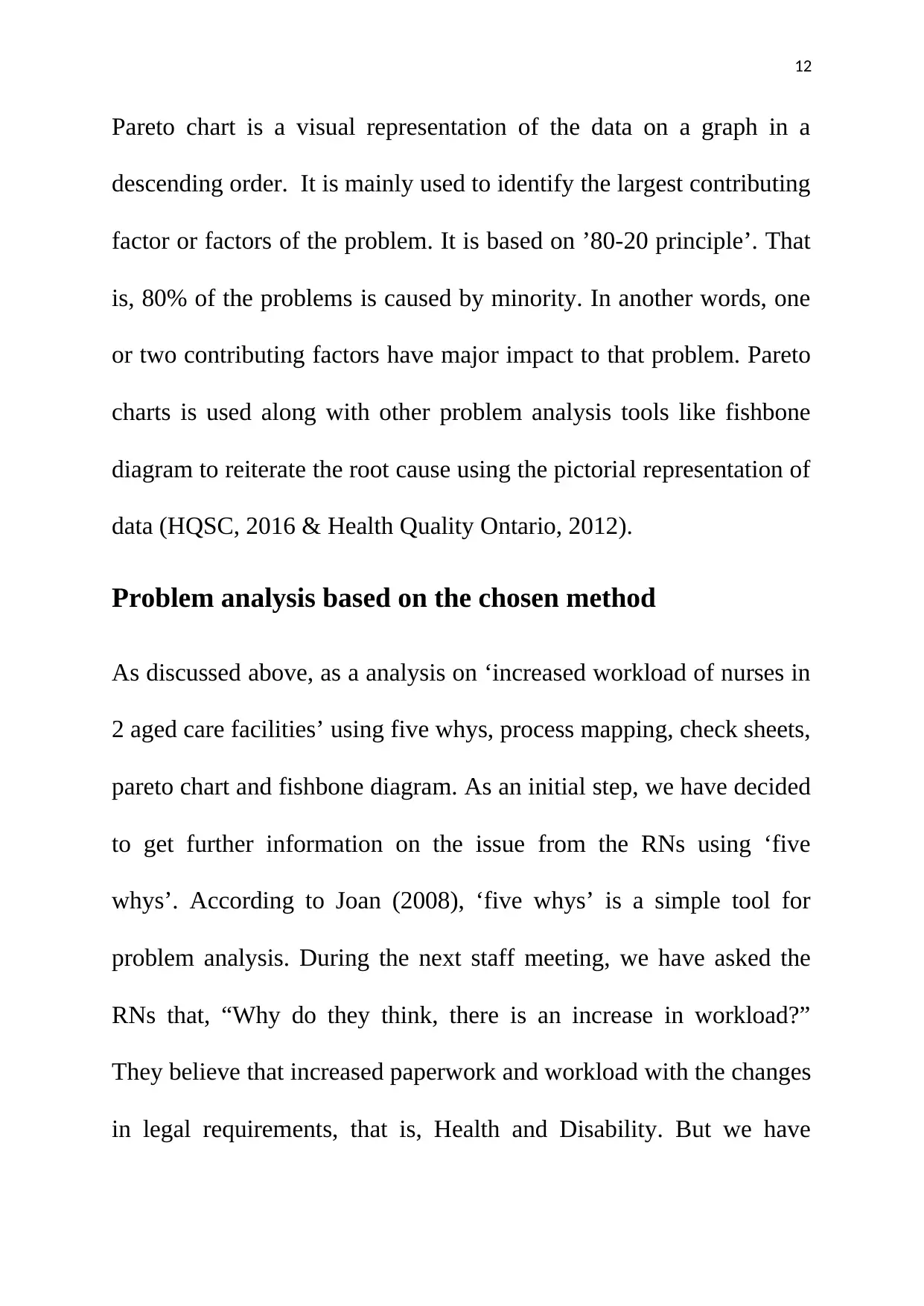
12
Pareto chart is a visual representation of the data on a graph in a
descending order. It is mainly used to identify the largest contributing
factor or factors of the problem. It is based on ’80-20 principle’. That
is, 80% of the problems is caused by minority. In another words, one
or two contributing factors have major impact to that problem. Pareto
charts is used along with other problem analysis tools like fishbone
diagram to reiterate the root cause using the pictorial representation of
data (HQSC, 2016 & Health Quality Ontario, 2012).
Problem analysis based on the chosen method
As discussed above, as a analysis on ‘increased workload of nurses in
2 aged care facilities’ using five whys, process mapping, check sheets,
pareto chart and fishbone diagram. As an initial step, we have decided
to get further information on the issue from the RNs using ‘five
whys’. According to Joan (2008), ‘five whys’ is a simple tool for
problem analysis. During the next staff meeting, we have asked the
RNs that, “Why do they think, there is an increase in workload?”
They believe that increased paperwork and workload with the changes
in legal requirements, that is, Health and Disability. But we have
Pareto chart is a visual representation of the data on a graph in a
descending order. It is mainly used to identify the largest contributing
factor or factors of the problem. It is based on ’80-20 principle’. That
is, 80% of the problems is caused by minority. In another words, one
or two contributing factors have major impact to that problem. Pareto
charts is used along with other problem analysis tools like fishbone
diagram to reiterate the root cause using the pictorial representation of
data (HQSC, 2016 & Health Quality Ontario, 2012).
Problem analysis based on the chosen method
As discussed above, as a analysis on ‘increased workload of nurses in
2 aged care facilities’ using five whys, process mapping, check sheets,
pareto chart and fishbone diagram. As an initial step, we have decided
to get further information on the issue from the RNs using ‘five
whys’. According to Joan (2008), ‘five whys’ is a simple tool for
problem analysis. During the next staff meeting, we have asked the
RNs that, “Why do they think, there is an increase in workload?”
They believe that increased paperwork and workload with the changes
in legal requirements, that is, Health and Disability. But we have
⊘ This is a preview!⊘
Do you want full access?
Subscribe today to unlock all pages.

Trusted by 1+ million students worldwide
1 out of 27
Related Documents
Your All-in-One AI-Powered Toolkit for Academic Success.
+13062052269
info@desklib.com
Available 24*7 on WhatsApp / Email
![[object Object]](/_next/static/media/star-bottom.7253800d.svg)
Unlock your academic potential
Copyright © 2020–2025 A2Z Services. All Rights Reserved. Developed and managed by ZUCOL.





